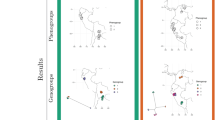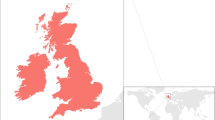Abstract
Many botanists doubt the existence of plant species1,2,3,4,5, viewing them as arbitrary constructs of the human mind, as opposed to discrete, objective entities that represent reproductively independent lineages or ‘units of evolution’. However, the discreteness of plant species and their correspondence with reproductive communities have not been tested quantitatively, allowing zoologists to argue that botanists have been overly influenced by a few ‘botanical horror stories’, such as dandelions, blackberries and oaks6,7. Here we analyse phenetic and/or crossing relationships in over 400 genera of plants and animals. We show that although discrete phenotypic clusters exist in most genera (> 80%), the correspondence of taxonomic species to these clusters is poor (< 60%) and no different between plants and animals. Lack of congruence is caused by polyploidy, asexual reproduction and over-differentiation by taxonomists, but not by contemporary hybridization. Nonetheless, crossability data indicate that 70% of taxonomic species and 75% of phenotypic clusters in plants correspond to reproductively independent lineages (as measured by postmating isolation), and thus represent biologically real entities. Contrary to conventional wisdom8, plant species are more likely than animal species to represent reproductively independent lineages.
This is a preview of subscription content, access via your institution
Access options
Subscribe to this journal
Receive 51 print issues and online access
$199.00 per year
only $3.90 per issue
Buy this article
- Purchase on Springer Link
- Instant access to full article PDF
Prices may be subject to local taxes which are calculated during checkout


Similar content being viewed by others
References
Levin, D. A. The nature of plant species. Science 204, 381–384 (1979)
Raven, P. H. in Modern Aspects of Species (eds Iwatsuki, K., Raven, P. H. & Bock, W. J.) 11–29 (Univ. of Tokyo Press, Tokyo, 1986)
Hickman, J. C. The Jepson Manual of Higher Plants in California (Univ. of California Press, Berkeley, 1993)
Bachmann, K. Species as units of diversity: an outdated concept. Theory Biosci. 117, 213–230 (1998)
Mishler, B. D. in Species: New Interdisciplinary Essays (ed. Wilson, R. A.) 307–316 (MIT Press, Cambridge, Massachusetts, 1999)
Fisher, R. A. in Evolution as a Process (eds Huxley, J. S., Hardy, A. C. & Ford, E. B.) 84–98 (Allen and Unwin, London, 1954)
Diamond, J. M. Horrible plant species. Nature 360, 627–628 (1992)
Grant, V. in The Species Problem (ed. Mayr, E.) 38–90 (American Association for the Advancement of Science, Washington DC, 1957)
Mayr, E. A local flora and the biological species concept. Am. J. Bot. 79, 222–238 (1992)
McDade, L. A. Species concepts and problems in practice: Insight from botanical monographs. Syst. Bot. 20, 606–622 (1995)
Berlin, B., Breedlove, D. E. & Raven, P. H. Principles of Tzeltal Plant Classification (Academic, New York/London, 1974)
Wang, J. X., Liu, H. M., Hu, H. B. & Gao, L. Participatory approach for rapid assessment of plant diversity through a folk classification system in a tropical rainforest: Case study in Xishuangbanna, China. Conserv. Biol. 18, 1139–1142 (2004)
Ridley, M. Evolution (Blackwell Scientific Publications, Oxford, 1996)
Mishler, B. D. & Donoghue, M. J. Species concepts: A case for pluralism. Syst. Zool. 31, 491–503 (1982)
Sokal, R. R. & Sneath, P. H. A. Principles of Numerical Taxonomy (W.H. Freeman and Company, San Francisco, 1963)
Baker, H. G. Race formation and reproductive method in flowering plants. Symp. Soc. Exp. Biol. 7, 114–145 (1953)
Carman, J. G. Asynchronous expression of duplicate genes in angiosperms may cause apomixis, bispory, tetraspory, and polyembryony. Biol. J. Linn. Soc. 61, 51–94 (1997)
McDade, L. A. & Lundberg, J. G. A new tabular and diagrammatic method for displaying artificial hybridization data, with an example from Aphelandra (Acanthaceae). Syst. Bot. 7, 13–25 (1982)
Arnold, M. L. Natural Hybridization and Evolution (Oxford Univ. Press, New York, 1997)
Morjan, C. L. & Rieseberg, L. H. How species evolve collectively: implications of gene flow and selection for the spread of advantageous alleles. Mol. Ecol. 13, 1341–1356 (2004)
Ehrlich, P. R. & Raven, P. H. Differentiation of populations. Science 165, 1228–1232 (1969)
Whitlock, M. C. Fixation probability and time in subdivided populations. Genetics 164, 767–779 (2003)
Levin, D. A. The Origin, Expansion, and Demise of Plant Species (Oxford Univ. Press, New York, 2000)
Mayr, E. The Growth of Biological Thought (Harvard Univ. Press, Cambridge, Massachusetts, 1982)
Price, T. D. & Bouvier, M. M. The evolution of F1 postzygotic incompatibilities in birds. Evolution 56, 2083–2089 (2002)
Coyne, J. A. & Orr, H. A. “Patterns of speciation in Drosophila” revisited. Evolution 51, 295–303 (1997)
Russell, S. T. Evolution of intrinsic post-zygotic reproductive isolation in fish. Ann. Zool. Fenn. 40, 321–329 (2003)
Sasa, M. M., Chippindale, P. T. & Johnson, N. A. Patterns of postzygotic isolation in frogs. Evolution 52, 1811–1820 (1998)
Presgraves, D. C. Patterns of postzygotic isolation in Lepidoptera. Evolution 56, 1168–1183 (2002)
Gray, A. P. Mammalian Hybrids: A Check-list with Bibliography (Commonwealth Agricultural Bureaux Farnham Royal, Slough, England, 1972)
Acknowledgements
Funding for this work was provided by the US National Institutes of Health, the US National Science Foundation, and the Guggenheim Foundation (to L.H.R.). We thank M. Barker, S. Bickford, A. Buerkle, J. Burke, B. Gross, M. Moody, J. Strasburg, Y. Supir, M. Tseng and K. Whitney for helpful comments on an earlier version of the manuscript, and the Centre for Plant Biodiversity Research at CSIRO Plant Industry, Australia for providing office space and library resources for this project. W. Hastie, M. Hearn and M. Thornton, from the CSIRO Black Mountain Library, provided extensive bibliographic assistance. Author Contributions L.H.R. conceived of the literature surveys, T.E.W. and L.H.R. collected the data, and E.J.B. and L.H.R. conducted the data analyses. The manuscript was written by L.H.R. with comments and assistance from T.E.W. and E.J.B.
Author information
Authors and Affiliations
Corresponding author
Ethics declarations
Competing interests
Reprints and permissions information is available at npg.nature.com/reprintsandpermissions. The authors declare no competing financial interests.
Supplementary information
Supplementary Methods
This file contains the Supplementary Methods and additional results. (DOC 101 kb)
Supplementary Table 1
Supplementary Table 1 nature04402-s2.doc Phenetic studies of plant species. (DOC 238 kb)
Supplementary Table 2
Phenetic studies of animal species. (DOC 119 kb)
Supplementary Table 3
Correspondence between crossability indices (CI), species taxa, and phenetic clusters. (DOC 85 kb)
Supplementary Table 4
Correspondence between species taxa and crossability indices (CIs) in plants. (DOC 211 kb)
Supplementary Table 5
Crossability indices (CIs) in plants (DOC 126 kb)
Supplementary Table 6
Correspondence between species taxa and crossability indices (CIs) in animals. (DOC 262 kb)
Supplementary Notes
This file contains additional references. (DOC 119 kb)
Rights and permissions
About this article
Cite this article
Rieseberg, L., Wood, T. & Baack, E. The nature of plant species. Nature 440, 524–527 (2006). https://doi.org/10.1038/nature04402
Received:
Accepted:
Issue Date:
DOI: https://doi.org/10.1038/nature04402
This article is cited by
-
Evolutionary distinctiveness with incomplete isolation of the narrow endemic alpine plant Saxifraga delphinensis Ravaud
Alpine Botany (2023)
-
An integrative genomic and phenomic analysis to investigate the nature of plant species in Escallonia (Escalloniaceae)
Scientific Reports (2021)
-
DNA barcoding of phytopathogens for disease diagnostics and bio-surveillance
World Journal of Microbiology and Biotechnology (2021)
-
Geography is essential for reproductive isolation between florally diversified morning glory species from Amazon canga savannahs
Scientific Reports (2019)
-
Low genetic differentiation between two morphologically and ecologically distinct giant-leaved Mexican oaks
Plant Systematics and Evolution (2019)
Comments
By submitting a comment you agree to abide by our Terms and Community Guidelines. If you find something abusive or that does not comply with our terms or guidelines please flag it as inappropriate.



